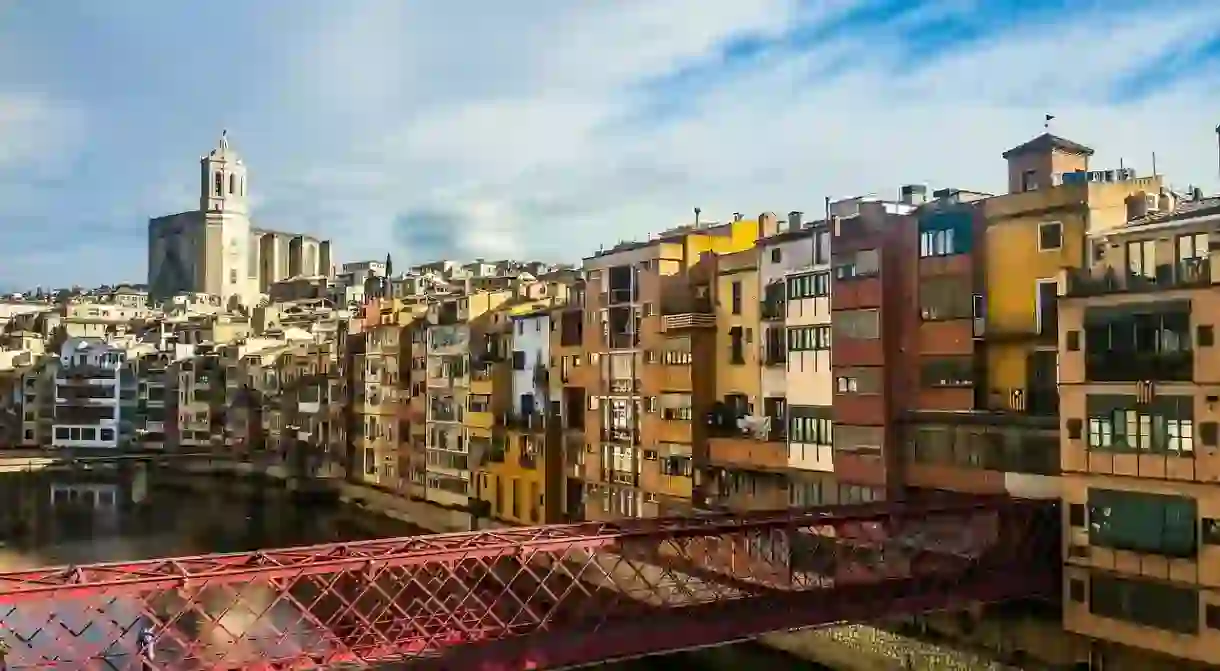A Walking Tour of Girona's Architectural Landmarks

The historic city of Girona lies within the province of Catalonia, approximately 100 kilometres north of Barcelona, and is filled with many fascinating architectural landmarks. Wind your way through its medieval alleyways and ancient Jewish Quarter to see sights such as the Plaça de la Independència, the Eiffel Bridge and the Basilica de Sant Feliu.
Eiffel Bridge (Pont de les Peixateries Velles)
Bridge

Begin your tour of Girona by crossing the River Onyar via the Pont de les Peixateries Velles, known as the Eiffel Bridge. Criss-crossed by red iron-work, it was built in 1877 by Frenchman Gustave Eiffel and his company, just before they built the famous Eiffel Tower in Paris. Make sure to stop to admire the colourful yellow and orange houses along the river banks. The façades were painted according to a palette created by Enric Ansesa, James J. Faixó and the architects Fuses and J. Viader. One of these houses, Casa Masó, is the birthplace of the architect Rafael Masó and is open to the public.
Plaça de la Independència

Turn right onto Carrer de Santa Clara and walk for three minutes until you reach the impressive Plaça de la Independència and the heart of the city. The square was designed by Martí Sureda on the site of the old convent of Sant Agustí. Surrounded by porticoed arches, this neoclassical plaza is flanked by many restaurants and cafes – great spots for people watching. Walk into the centre and you’ll see a monument by sculptor Antoni Parera, erected in 1894 to commemorate the 1809 defenders of the city of Girona.
Basilica de Sant Feliu
Cathedral, Church

Continue straight across the square and follow Passeig Jose Canalejas along the river for a few minutes until you come to the Pont de Sant Feliu bridge. Cross the river again, and straight in front of you, you’ll see the impressive facade of the Basilica de Sant Feliu. The basilica began life as Girona’s first cathedral back in the 10th century, and is mostly Gothic in style. Later however, a Baroque facade was added from the 13th to the 18th centuries, and an elegant bell tower between the 14th and 16th centuries. Inside, you’ll find artwork including pagan and early Christian sarcophagi, dating back to the 4th century, and the 14th century Recumbent Christ statue by the sculptor Aloi de Montbrai.
Banys Àrabs
Archaeological site, Building, Museum

Make your way round behind the church for a one minute stroll until you find the city’s ancient Arab Baths. The baths were ordered to be built by King Alfons I and its oldest parts date back to 1194. Although it is actually Roman, not Arabic, it still has many Moorish architectural influences.
Monestir de Sant Pere de Galligants
Monastery, Museum

Follow your route down Carrer del Bellaire and then double back on yourself to head up Carrer del Riu Galligants for three minutes until you come across the walls of the the monastery of Sant Pere de Galligants and the church of Sant Nicolau. Head inside to see the charming cloisters of this 12th-century Romanesque Benedictine monastery. It’s also home to the Archeological Museum.
Girona Cathedral
Cathedral, Museum

Make your way back the way you came towards the Arab Baths, then follow the narrow street into Plaça dels Jurats – one of the filming locations for Game of Thrones season 6 – then continue onto Carrer de Ferran el Catòlic. From here, turn left onto Carrer de la Força, under the stone archway and you’ll find yourself at the bottom of the 91 stone steps leading up to Girona Cathedral. Built between the 11th and 18th centuries, it features varying architectural styles including a Baroque facade and Romanesque cloisters. The most striking feature however is its Gothic nave, built between the 15th and 16th centuries. At 23 metres, it’s the widest Gothic nave in the world.













